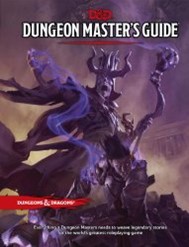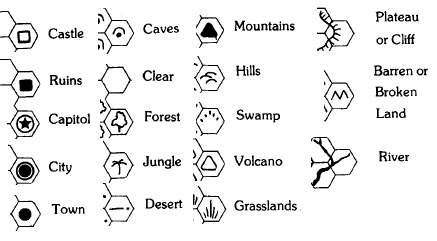 Dungeons & Dragons play is traditionally divided into three environments: Dungeon, Urban and Wilderness. Of those three, the Dungeon is by far the easiest to prepare and run. The Wilderness, on the other hand, is something I find particularly challenging to DM. The early D&D booklets suggested using the map of Outdoor Survival (an Avalon Hill boardgame) to represent the wilderness just around the dungeon, and to use random encounters (for the most part) to determine what the players found.
Dungeons & Dragons play is traditionally divided into three environments: Dungeon, Urban and Wilderness. Of those three, the Dungeon is by far the easiest to prepare and run. The Wilderness, on the other hand, is something I find particularly challenging to DM. The early D&D booklets suggested using the map of Outdoor Survival (an Avalon Hill boardgame) to represent the wilderness just around the dungeon, and to use random encounters (for the most part) to determine what the players found.
The hex map (as used in Outdoor Survival) became the default way of representing outdoor environments, just as the square grid became the default way of representing dungeons. One of the elements lifted from Outdoor Survival and incorporated into the game was a chance of becoming lost and proceeding in the wrong direction. In the latest edition of D&D, such a chance could be represented by a Wisdom (Survival) check, and you’ll note that navigating is one of the activities that could be quite important when travelling outdoors in 5E! The original release also suggested that the area around the initial dungeon should be mapped out by the DM and then revealed as the players explore – one hex at a time!
Typically, a group of players would have a blank hex grid, and they’d fill in each hex with a symbol representing the terrain found there (as marked on the DM’s map).
There are two significant published adventures that make use of this exploration tactic. The first is the classic Isle of Dread, for character levels 3-7, in which the characters explore an island on which prehistoric monsters live, as well as a number of strange and unnatural creatures – The Lost World crossed with The Call of Cthulhu. The players get a map with the coastline, but all the interior spaces are blank hexes and need to be filled in as the group explores. The second is more recent, Paizo’s Kingmaker series, which has the players exploring a blank map with the eventual goal of conquering the lands they discover and adding them to their kingdom.
My experiences with DMing both adventures (and my own besides) that have the players filling in a blank map indicate that players are really bad at working out what hex they’re currently in. This technique can take a lot of time. (It’s also rather frustrating for the players when they get lost and have to redraw the map!) As a result, I don’t use it as the default method of running wilderness games unless the adventure focuses on the exploration of the wilderness. If your chief interest is just to get from one place to another, don’t require the players to fill out a map. Use a more narrative method of handling the wilderness. (I plan to write about that in an upcoming article). However, for an exploration adventure, filling in a blank map works fine.
As a DM, you’ll need to draw a map of the wilderness for your party to explore and to stock it with interesting things for them to discover. It’s no good to have a map of 100 hexes with only one hex holding something interesting. You need several prepared areas so that the players don’t find it dull to explore. Every few hexes of exploration should have them discovering something new and interesting.
So, what things can you stock the wilderness with? Here are a few suggestions:
- Monster Lairs
- Settlements
- Castles and Strongholds
- Monuments and Ruins
- Unusual natural features (bridges, rock formations, gold-flecked streams)
- Wilderness hazards
A discussion of a few things you might find can be found on pages 108-9 of the Dungeon Master’s Guide.
Castles
In the original D&D, finding castles and strongholds – inhabited or otherwise – was a major component of the wilderness encounter tables. Of course, you don’t want them to be too close together, so do use your judgement when placing them, but they provide a major encounter for the players. They may provide aid to a weary group of adventurers, or provide a group of foes that must be defeated if the adventurers are to remain in the area. Anyone strong enough to hold a castle is likely to be good for a few recurring appearances!
Adapted from the tables in original AD&D Dungeon Masters Guide, here are a few suggestions for castles:
Size: (1d6): 1-2: Small (Small shell keep, tower or moat house); 3-5: Medium (Large shell keep, walled castle with keep); 6: Large (concentric castle, fortress complex).
Inhabitants: (1d10 , +1 medium, +2 large): 1-4: Totally Deserted, 5-6: Deserted with monster; 7: Bandits; 8-10: Characters. (Bandits. Bandit forces tend to be 20-200 bandits and their leaders. Characters could be (d10) 1-4: Fighters, 5: Wizards, 6-8: Clerics, 9-10: Rogues, with a force of 40-80 men-at-arms and soldiers guarding the stronghold.) Deserted strongholds tend to be in poor repair.
I would typically determine the alignment of character-types at random to gain an idea of their personality and how they might react to the players.
How common are castles? If you’re using 1-mile hexes, the chance is about 1 in 100 (a calculation based on how many castles there are in Devon, England). With 6-mile hexes (an area of about 32 square miles), it becomes about a 1 in 3 chance of finding one in each hex! Obviously, those numbers should be adjusted according to the area where the players are adventuring.
Scale
What scale should the map be? For exploration adventures, you tend to want the map to be either at the 1-mile per hex or the 6-miles per hex scale. A 30-mile per hex scale, which is typical of large-scale overland maps (such as the classic Greyhawk map) is basically only useful for travel.
1-mile hexes allow for a greater level of detail – you can map quite small features on this map – but I’m not that fond of that scale primarily because you can see several hexes in each direction… and that means you should probably describe quite a few hexes as the players move, thus slowing the play down more. There are times when the 1-mile scale is appropriate, but I tend to prefer the 5-mile or 6-mile hexes. At that scale, adventurers really can’t see into the next hex that easily, and the encounters they do have tend to be more significant.
Symbols
Here are a few symbols for representing wilderness map features, taken from the D&D Expert game (1981). You can design your own symbols, or use the more complex computer-generated graphics available today, but my own play dates back from this set, and they’re easy to remember when mapping as a player.

